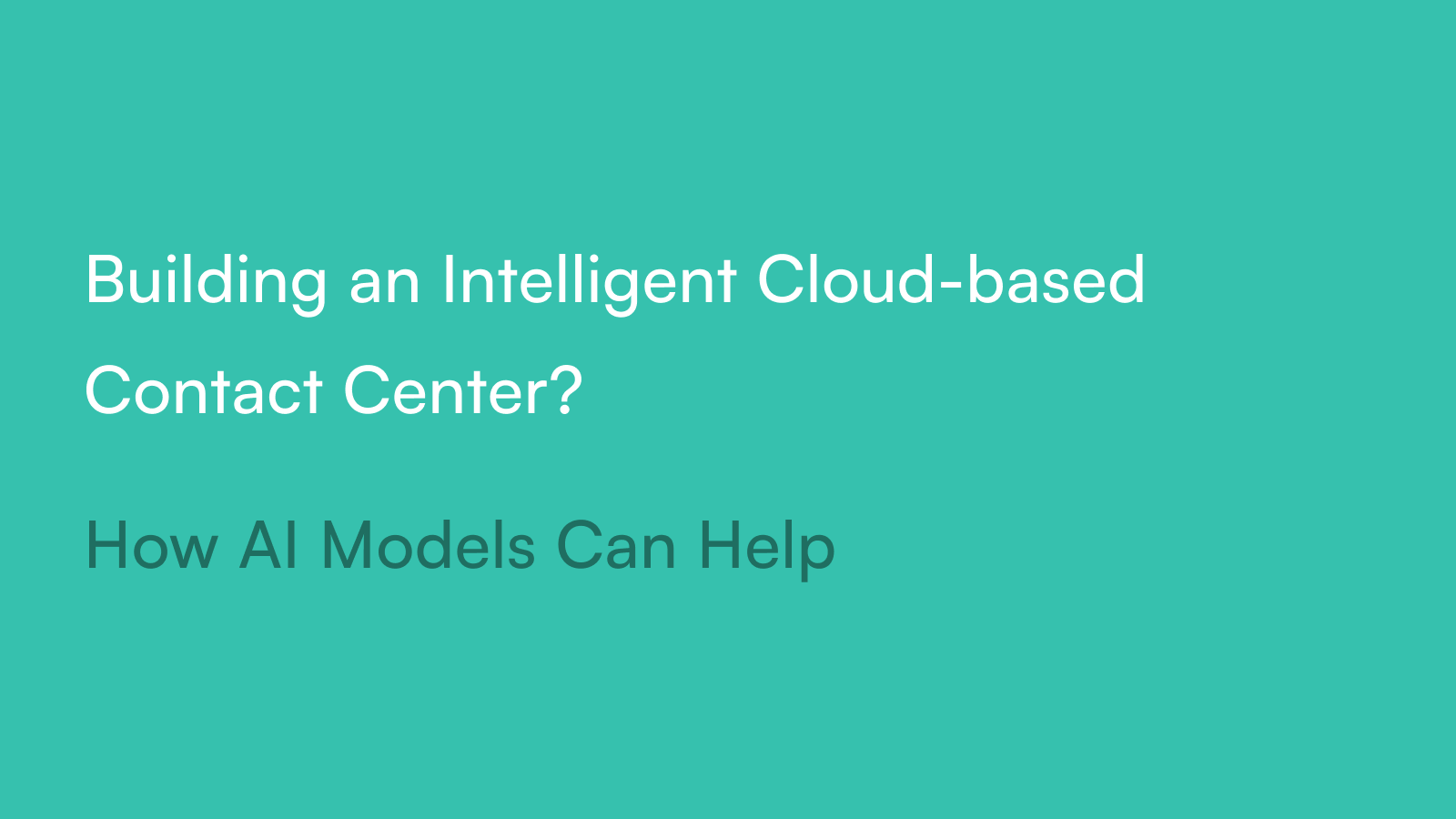Fifty-six percent of contact centers plan to invest in AI technology. But choosing the right AI tech is key to success today and for safeguarding that success into the future.
Whether it’s to optimize workflows that increase agent productivity, automate QA management, or support more efficient agent training, many leaders in Cloud-based Contact Centers as a Service (CCaaS) are choosing AI-powered Automatic Speech Recognition (ASR), Natural Language Processing (NLP), and Natural Language Understanding (NLU) solutions.
This article will explore how ASR, NLP, and NLU tools and AI Models can help CCaaS companies:
- Enhance contact center performance with insights to increase agent occupancy.
- Discover customer insights regarding satisfaction, risks, brand strength, churn, and competitor intelligence.
- Improve quality monitoring by reviewing large samples in a short period of time.
First, we’ll explore the basics behind intelligent Cloud-based Contact Centers and ASR before examining these top three ways that AI, Machine Learning, and NLU serve as foundational and exemplary tools for CCaaS.
What are Cloud-based Contact Centers?
Cloud-based Contact Centers as a Service, or CCaaS, are cloud-based customer communications platforms. The goal of a CCaaS platform is to provide high quality, highly personalized interactions between an organization and its customers to solve problems before they occur and to boost customer loyalty. One study found that customers rated companies that are more proactive in their customer service as more “pleasant” or “positive.”
On average, buyers engage with companies via 13 separate channels–CCaaS platforms let agents see this entire contact history between an organization and a customer, across inbound phone calls, emails, social media, text messages, and more. This is different from a call center, which only records interactions that occur via the phone
Other challenges that CCaaS platforms hope to solve for end users include a lack of customer data, siloed CXM, a lack of omnichannel support, and missing qualitative information.
What Services does a CCaaS Platform Offer?
Typically, a CCaaS platform will offer several primary services:
- Call queuing and routing
- Call recording and transcription
- Agent training to enhance customer service
- Call trends and analytics
Today, many CCaaS platforms are turning to AI to equip their agents with as much customer knowledge as possible and optimize these services.
Speech-to-Text and Audio Intelligence for Cloud-based Contact Centers
One of these AI-backed technologies is Automatic Speech Recognition, or ASR. This includes top Speech-to-Text APIs that can automatically transcribe calls at near-perfect accuracy. In the past, transcription texts had low accuracy and minimal structure–most lacked basic punctuation and casing, paragraph structure, or speaker labels, making it difficult for readers to get much use out of a transcription.
However, significant advances in AI, Deep Learning, and Machine Learning research have pushed model accuracy higher, while also supporting a more user-friendly transcription text that reads like a book or script. These models are trained on texts with billions of words, like AssemblyAI’s recently updated Automatic Casing and Punctuation Model, that make accessible, accurate transcription attainable for all.
In addition, some speech recognition APIs offer even more advanced NLU/NLP tools. These are referred to as Audio Intelligence APIs.
By applying cutting-edge Machine Learning, Deep Learning, and NLP research, Audio Intelligence APIs let CCaaS platforms quickly build high ROI features and applications on top of customer audio data. This could include automatically labeling multiple speakers in a phone call, detecting common entities, ascribing customer sentiment, summarizing key sections of phone calls, and more.
Now, let’s look at the three biggest impacts Speech-to-Text and Audio Intelligence technology can have on CCaaS platforms:
1. Enhance Contact Center Performance
Speech-to-Text and Audio Intelligence APIs significantly enhance a CCaaS platform’s overall performance. Here’s how.
First, by automating highly accurate transcription, contact centers can decrease the amount of time an agent spends between calls and increase the time an agent spends doing what really matters–taking calls. This is referred to as increasing agent occupancy. Agent occupancy is typically thought of as an agent’s total handle time divided by an agent’s total time available for work. By increasing this number, a contact center directly increases its ROI for each agent.
A few ASR and NLU APIs can help boost agent occupancy. First, by automating call transcription, agents don’t have to worry about jotting down notes, filling out CRM data, or other manual data entry tasks.
In addition, an Auto Chapters (Summarization) API can provide a “summary over time” for transcription texts. It works by segmenting an audio file into logical chapters, or where the conversation naturally changes topic. Then, the API will generate a summary for each of these chapters, making the transcription more digestible at a glance. With Auto Chapters, an agent doesn’t need to spend 10-15 minutes post-call writing down notes or drafting emails summarizing the calls manually–so the agent can get on the next customer call faster.
Transcriptions can even easily be sorted with appropriate speaker labels, such as agent and customer A through a process called Speaker Diarization. By automatically detecting and accurately labeling multiple speakers in the audio stream, Speaker Diarization makes transcripts instantly more readable and easily digestible.
Moreover, by automating these once manual processes, contact centers improve the customer experience as well, as agents can be more attentive to the customer’s needs and questions during the call.
In addition, Speech-to-Text and Audio Intelligence APIs can help ensure agents stick to talk tracks or even include language required by compliance regulations by industry standard, such as “This call is being recorded for XYZ purposes.” Easily sort and analyze transcripts using Speaker Diarization discussed above or use a Word Search feature to search for specific keywords, phrases, or numbers in a transcription text.
2. Discover Customer Insights
In addition to enhancing contact center performance, Speech-to-Text and Audio Intelligence APIs can also help platform users discover more intelligent, actionable customer insights regarding customer satisfaction, potential risks, perceived brand strength, or even competitor intelligence.
These customer conversations hold extremely valuable data about brands and businesses–contact centers have to unlock these insights for their users in tangible ways that generate high ROI.
Two main Audio Intelligence APIs can help CCaaS platforms build this feature: Entity Detection and Sentiment Analysis.
Entity Detection, or Named Entity Recognition, identifies and classifies key information in a transcription text. For example, San Francisco is an entity that is classified as a location.
Other common entities that can be detected in a transcription text include:
With Entity Detection, CCaaS platforms can help users identify mentions of their company name, a competitor’s company name, specific people, locations, events, and more. Then, platforms help users use this information to populate associated fields in the CRM, categorize conversations and improve customer response time, or aggregate data for further analytics and appropriate actions.
Sentiment Analysis is another Audio Intelligence APIs that helps provide strategic insights for CCaaS platform users. By analyzing and accurately labeling speech segments in a transcription text as positive, negative, or neutral, contact centers can help users track customer feelings and feedback about products, specific agents, events, or competitors. Or, Sentiment Analysis can be used to analyze agent behavior and associated customer responses–do certain sentiments generate desired actions? Like with Entity Detection, Sentiment Analysis data can be aggregated to generate informed actions across agent training, call tracks, and more.
When combined, Entity Detection and Sentiment Analysis can also work together to provide deeper insights–are brand name mentions associated with more positive or negative comments? What about specific products? Does location, time of day, or agent have an effect on sentiment?
3. Improve Quality Monitoring
Finally, Speech-to-Text and Audio Intelligence APIs help CCaaS platforms build tools that greatly improve quality monitoring for end users.
Companies using contact centers have hours and hours of calls to sift through each day. Beyond transcription, CCaaS platforms need to help users make these calls more digestible, supporting reviews of even the longest calls in mere minutes for more effective QA management.
Two main Audio Intelligence APIs can help with this: Auto Chapters (Summarization) and Entity Detection.
As discussed previously, an Auto Chapters (Summarization) API automatically summarizes each call at high accuracy while Entity Detection identifies recurring entities, like locations, in a transcription text. When used together, these Audio Intelligence APIs let CCaaS platforms support easy search across action items, important highlights, or themes across transcriptions, aiding easier QA management or other analysis.
In addition, many companies that use call centers have compliance requirements to follow and must be able to accurately redact sensitive information. Here, Personally Identifiable Information (PII) Redaction APIs can help contact centers build out this tool by locating all specified PII data in a transcription text and replacing each character with # instead. For example, a phone number that was 639-8749 would be automatically written as ###-#### in the transcription text.
Common PII that can be redacted include:
PII Redaction helps ensure automatic compliance to laws, regulations, or internal requirements.
Intelligent Cloud-based Contact Centers
CCaaS platforms need intelligent tools to offer a competitive service for end users. Speech-to-Text and Audio Intelligence APIs help contact centers build out these smart features that directly improve overall contact center performance, help end users discover actionable customer insights, and boost quality monitoring.
Because these ASR and NLP/NLU tools are built using the latest AI, Machine Learning, and Deep Learning research, contacts centers can ensure that their platform is equipped with State-of-the-Art features and accuracy, securing a competitive advantage into the future.







